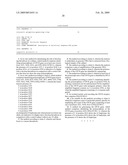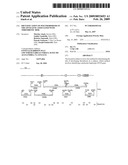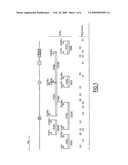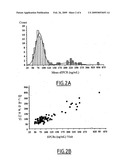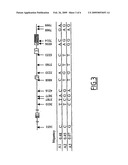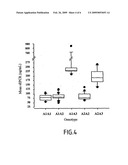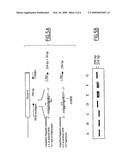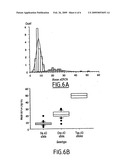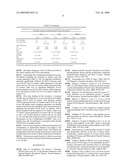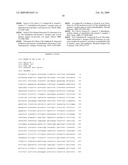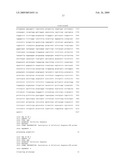Patent application title: Identification of polymorphisms in the epcr gene associated with thrombotic risk
Inventors:
Martine Aiach (Sevres, FR)
Sophie Gandrille (Paris, FR)
Beatrice Saposnik (Paris, FR)
Pascale Gaussem (L'Hay Les Roses, FR)
Joseph Emmerich (Paris, FR)
IPC8 Class: AC12Q168FI
USPC Class:
435 6
Class name: Chemistry: molecular biology and microbiology measuring or testing process involving enzymes or micro-organisms; composition or test strip therefore; processes of forming such composition or test strip involving nucleic acid
Publication date: 2009-02-26
Patent application number: 20090053693
Claims:
1. An in vitro method for determining the risk of developing thrombosis in
a subject, which method comprises identifying polymorphisms of EPCR gene
on at least one of positions 1651, 3610, 4216, and 6936 (SEQ 10 NO:1),
wherein the presence of G at position 1651, C at position 3610, A at
position 4216, or G at position 6936 is indicative of a higher risk to
develop thrombosis in comparison with a control subject that does not
show the same polymorphisms.
2. An in vitro method according to claim 1, which method comprises identifying polymorph isms of EPCR gene at positions 1651, 3610, 4216, 6936, 3787, 3877, 4868, 5233, 5760, 6333, 7014, 7968, 7999 of SEQ 10 NO: 1, wherein the simultaneous presence of:G at position 1651C at position 3610A at position 4216G at position 6936C at position 3787G at position 3877T at position 4868G at position 5233T at position 5760T at position 6333G at position 7014A at position 7968G at position 7999are designated A3 haplotype and, when present on at least one allele, are indicative of a higher risk to develop thrombosis in comparison with a control subject without any A3 allele.
3. The method according to claim 1, wherein said thrombosis is a venous thrombosis.
4. The method according to claims 1, wherein the analysis is undertaken on genomic DNA that is extracted from a biological sample of the subject.
5. The method according to claim 1, wherein the analysis comprises a step of amplification of the genomic DNA.
6. The method according to claim 1, wherein the polymorphisms of the EPCR gene are identified by sequencing.
7. The method according to claim 1, wherein at least one of the polymorph isms of the EPCR gene is identified by RFLP analysis.
8. The method according to claim 7, comprising identifying the polymorphism of EPCR gene on position 6936, by creating a restriction site for endonuclease PstI by amplification of the EPCR gene with mutagenic primers, when the amplified fragment contains an A at position 6936, so that when the amplified fragment containing a G, it remains undigested.
9. An isolated nucleic acid encoding the EPCR receptor, that comprises SEQ ID NO:2.
10. A kit suitable for the methods according to claim 1, which kit comprises a pair of nucleotide primers specific for amplifying all or part of the EPCR gene comprising at least one of positions 1651, 3610, 4216 of SEQ ID NO:1.
11. A method for genotyping the EPCR gene, which method comprises identifying the polymorphism of the EPCR gene at position 4216 (SEQ ID NO: 1), wherein the presence of C at position 4216 shows the A1 haplotype, the presence of G at position 4216 shows the A2 haplotype, and the presence of A shows the A3 haplotype.
Description:
[0001]The present invention relates to methods for assessing a genetic
risk of thrombosis.
[0002]The protein C(PC) system is an important natural anticoagulant mechanism. PC, a vitamin K-dependent zymogen, is activated at the endothelial surface when thrombin binds to thrombomodulin, a protein that transforms the procoagulant enzyme into a potent activator of PC. In the presence of its cofactor, protein S, activated protein C (aPC) inactivates factor Va and VIIIa, thereby reducing thrombin generation (Dahlback et al., (1995)).
[0003]Another factor contributing to protein C activation--endothelial cell activated protein C receptor (EPCR)--was discovered more recently at the surface of endothelial cells (Fukudome et al. (1994)). This receptor, which can bind PC or aPC with the same affinity (Kd=30 nM), is mainly expressed on endothelial cells of large vessels (Laszik et al. (1997); Ye et al. (1999); Fukudome et al. (1998)).
[0004]Functional studies performed in vitro showed a 3- to 5-fold increase in the PC activation rate by the membrane thrombin-thrombomodulin complex when PC is bound to its receptor (Stearns-Kurosawa et al. (1996)). This increase results from a significant effect of EPCR on the Km for PC activation by the thrombin-thrombomodulin complex. Indeed, without EPCR intervention, this Km is significantly higher (1 μM) than the circulating concentration of PC (60-70 nM). By presenting PC to the thrombin-thrombomodulin complex, and owing to its lateral mobility, EPCR reduces the Km and thereby allows the interaction to occur.
[0005]In view of these functions, EPCR was expected to intervene in the physiological regulation of coagulation. Evidence for an important role of this type came from baboon studies (Taylor et al. (2000); Taylor et al. (2001)), in which an 88% reduction in aPC generation induced by thrombin infusion was observed in animals that had been pretreated with anti-EPCR antibodies blocking the PC/EPCR interaction.
[0006]EPCR is a 46-kD type 1 transmembrane glycoprotein homologous to major histocompatibility complex class I/CD1 family proteins (Fukudome et al. (1994); Villoutreix et al. (1999); Liaw et al. (2001). This 221-amino-acid (aa) protein comprises an extracellular domain, a 25-aa transmembrane domain, and a short (3 aa) intracytoplasmic sequence. The gene is located on chromosome 20 (Hayashi et al. (1999), at position q11.2; it spans 8 kb and comprises 4 exons (Hayashi et al. (1999); Simmonds et al. (1999). The first exon encodes the 5' untranslated region and the signal peptide, exons 2 and 3 most of the extracellular domain, and exon 4 the remaining parts of the protein and the 3' untranslated region. The proximal part of the promoter was recently functionally characterized (Rance et al. (2003).
[0007]Several authors have reported the presence in plasma of a soluble form of EPCR (sEPCR) (Kurosawa et al. (1997); Kurosawa et al. (1998)) that probably lacks the transmembrane domain and cytoplasmic tail. This sEPCR is detected as a single species of 43 kD, resulting from shedding of membrane EPCR by the action of a metalloprotease (Xu et al. (2000)) which is stimulated by thrombin and by some inflammatory mediators (Gu et al. (2000)). Soluble EPCR binds PC and aPC with similar affinity (Fukudome et al. (1996); Regan et al. (1996)), but its binding to aPC inhibits the anticoagulant activity of aPC by blocking its binding to phospholipids and by abrogating its ability to inactivate factor Va (Liaw et al. (2000)). By contrast with the membrane-associated form of EPCR, PC binding to sEPCR does not result in enhanced aPC generation by the thrombin-thrombomodulin complex (Regan et al. (1996)). A recombinant sEPCR has recently been crystallized (Oganesyan et al., 2002).
[0008]Dysfunctional EPCR-dependent activation of PC would potentially be thrombogenic. A loss of function could result from mutations leading to decreased expression of membrane EPCR. A 23-bp insertion has been reported to impair EPCR functions by leading to the synthesis of a truncated protein that is not expressed on endothelial surfaces (Biguzzi et al. (2001)). Although initially identified in thrombophilic subjects (von Depka et al. (2001)), the role of this mutation in thrombosis is difficult to assess because its allelic frequency is low (von Depka et al. (2001); Akar (2002); Poort et al. (2002); Galligan et al. (2002)). Point mutations were recently described within the promoter region (Biguzzi et al. (2002)) of the gene in four thrombophilic subjects, but the involvement of these mutations in gene regulation could not be clearly demonstrated.
[0009]Another possible mechanism leading to dysfunction of the EPCR-mediated coagulation-regulating mechanism consists of mutations (or polymorphisms) leading to increased levels of sEPCR. Indeed, increased sEPCR levels may be prothrombotic, as sEPCR can inhibit aPC activity, as well as PC activation, by competing for PC with membrane-associated EPCR.
[0010]Two recent studies show that sEPCR levels vary widely among healthy subjects (Stearns-Kurosawa et al. (2002); Stearns-Kurosawa et al. (2003). While sEPCR levels are between 75 and 178 ng/mL in 80% of subjects, the remaining 20% of subjects have values between 200 and 700 ng/mL. This bimodal distribution has repeatedly been reported in both French and Italian populations (Stearns-Kurosawa et al. (2003)).
[0011]Several polymorphisms in the EPCR have been studied for possible association with the risk of thrombosis.
[0012]G/A polymorphism affecting nt 6936 has been described in two different studies, both of which showed a very similar frequency of the G allele in thrombophilic and control Caucasian subjects (Espana et al 2001, wherein the polymorphism was designated A7685; Poort et al 2002, wherein the polymorphism was designated A4300G).
[0013]The 7014 G/C polymorphism has also been reported in three studies (Espana et al 2001, Galligan et al 2002 and Medina et al 2003) wherein the polymorphism was designated G7763C, G5252C and G4678C, respectively.
[0014]Finally, a third polymorphism corresponding to nt 4868 has been described by Poort et al (2002) with T3997C numbering.
[0015]In the XVIIIth Congress of the International Society on Thrombosis and Haemostasis (July 2001), Espana et al reported that an EPCR allele bearing the 4678 C polymorphism (that corresponds to nt 7014 polymorphism described here) has a protective effect against thrombosis, and at the XIX Congress of the International Society on Thrombosis and Haemostasis (July 2003), Navarro et al described a similar effect of this allele in thrombophilic carriers of the factor V Leiden mutation.
[0016]The inventors now extensively analysed the EPCR gene and identified several polymorphisms that were in complete linkage disequilibrium, defining three haplotypes (designated A1, A2 and A3). One of three haplotypes was associated with increased sEPCR levels, offering the first evidence that inter-individual variations in sEPCR levels are genetically regulated.
[0017]As sEPCR can inhibit both aPC generation and aPC activity, the inventors examined whether the haplotype associated with high sEPCR levels carried an increased risk of venous thrombosis. On comparing 338 subjects with thrombosis and 338 age- and sex-matched healthy controls, the inventors observed a significantly higher allelic frequency of this haplotype in the cases.
[0018]Based on these results, the present invention provides a method for distinguishing A1, A2 and A3 haplotypes in the EPCR receptor, the latter being associated with a higher risk to develop thrombosis.
[0019]This method is thus useful to determine the risk of developing thrombosis, especially venous thrombosis, in a subject.
EPCR Receptor
[0020]As above mentioned, the human EPCR receptor has been cloned. EPCR has also been characterized in other species, such as mouse and bovine:
TABLE-US-00001 Gene mRNA Protein (EMBL/Genbank) (EMBL/Genbank) Swissprot PIR Human AF106202 L35545 Q9UNN8 A55365 Mice AF162695 L39017 Q64695 A55945 AF224271 Bovine L39065 Q28105 B55945
[0021]In the context of the present invention, the term "EPCR" or "EPCR receptor" refers to the EPCR receptor of any species, especially in human, but also in other mammals or vertebrates to which the methods of the invention can apply, if desired. The term "subject" thus refers to any human patient or any mammal or vertebrate.
[0022]The human EPCR gene sequence is available on Genbank (access number: AF106202), and is also shown in SEQ ID NO:1 (A2 haplotype). In this sequence, the starting codon for the open reading frame is located at nucleotide 2337.
[0023]A chromosomal sequence is also available on Genbank (AL 356652), and corresponds to the A1 haplotype. In that sequence, the EPCR gene is located from nucleotide 29655 to nucleotide 37818.
[0024]A sequence of the A3 haplotype is represented as SEQ ID No: 2.
Haplotypes
[0025]The inventors found various nucleotide polymorphisms (SNPs) in the EPCR gene. In the present invention, these polymorphisms are sometimes referred to as "the polymorphic positions of interest".
[0026]To make it simple, these polymorphisms are herein numbered according to SEQ ID No:1, starting from nucleotide 1.
[0027]However it should be noted that this numbering is arbitrary.
[0028]The identified SNPs defined three haplotypes, that were designated A1, A2 and A3.
[0029]As shown in FIG. 3, A1 and A2 were major haplotypes, with allelic frequencies of 0.48 and 0.45, respectively. The A1 haplotype consisted of a combination of T at nt 3787, A at nt 3877, C at nt 4216, C at nt 4868, A at nt 5233, C at nt 5760, C at nt 6333, C at nt 7014, G at nt 7968 and A at nt 7999. The A2 haplotype was a combination of C at nt 3787, G at nt 3877, G at nt 4216, T at nt 4868, G at nt 5233, T at nt 5760, T at nt 6333, G at nt 7014, A at nt 7968 and G at nt 7999. A3, the least common haplotype (allelic frequency 0.07), differs from A2 haplotype at four nucleotide positions (G at nt 1651, C at nt 3610, A at nt 4216 and G at nt 6936).
[0030]The A3 haplotype is thus defined as the simultaneous presence of the following polymorphisms: [0031]G at position 1651 [0032]C at position 3610 [0033]A at position 4216 [0034]G at position 6936 [0035]C at position 3787 [0036]G at position 3877 [0037]T at position 4868 [0038]G at position 5233 [0039]T at position 5760 [0040]T at position 6333 [0041]G at position 7014 [0042]A at position 7968 [0043]G at position 7999
[0044]The isolated nucleic acid of the EPCR receptor gene with the A3 haplotype is also part of the present invention.
[0045]A subject of the invention is thus an isolated nucleic acid encoding the EPCR receptor, which nucleic acid comprises the EPCR gene sequence with the simultaneous presence of: [0046]G at position 1651 [0047]C at position 3610 [0048]A at position 4216 [0049]G at position 6936 [0050]C at position 3787 [0051]G at position 3877 [0052]T at position 4868 [0053]G at position 5233 [0054]T at position 5760 [0055]T at position 6333 [0056]G at position 7014 [0057]A at position 7968 [0058]G at position 7999
[0059]Such nucleic acid preferably comprises SEQ ID No: 2.
[0060]The identification of any of: [0061]G at position 1651 [0062]C at position 3610 [0063]A at position 4216 [0064]G at position 6936
[0065]is sufficient to identify the A3 haplotype.
[0066]Conversely, the presence of a C nucleotide at position 4216 marks the existence of the A1 haplotype, whereas the presence of a G nucleotide at position 4216 marks the existence of the A2 haplotype.
[0067]It is therefore provided a method for genotyping the EPCR gene, which method comprises identifying the polymorphism of the EPCR gene at position 4216 (SEQ ID No: 1), wherein the presence of C at position 4216 shows the A1 haplotype. The presence of G at position 4216 shows the A2 haplotype, and the presence of A shows the A3 haplotype, the latter being associated with a higher risk to develop thrombosis. It was further shown that the individuals carrying the A1 haplotype have a lower thrombotic risk (Medina et al., 2004).
[0068]Various methods for identifying the polymorphisms at position 4216 are described in greater details below, in connection with the identification of the A3 allele. The skilled person will recognize that the same type of methods may be used with regard to the identification of the A1 or A2 haplotypes.
Thrombosis Risk
[0069]The present invention provides an in vitro method for determining the risk of developing thrombosis in a subject, which method comprises identifying polymorphisms of EPCR gene on at least one of positions 1651, 3610, 4216, and 6936, wherein the presence of G at position 1651, C at position 3610, A at position 4216, or G at position 6936 is indicative of a higher risk to develop thrombosis in comparison with a control subject that does not show the same polymorphisms.
[0070]In a preferred embodiment, the method comprises identifying polymorphisms of EPCR gene at positions 1651, 3610, 4216, 6936, 3787, 3877, 4868, 5233, 5760, 6333, 7014, 7968, 7999 of SEQ ID No: 1, wherein the simultaneous presence of: [0071]G at position 1651 [0072]C at position 3610 [0073]A at position 4216 [0074]G at position 6936 [0075]C at position 3787 [0076]G at position 3877 [0077]T at position 4868 [0078]G at position 5233 [0079]T at position 5760 [0080]T at position 6333 [0081]G at position 7014 [0082]A at position 7968 [0083]G at position 7999are designated A3 haplotype and, when present on at least one allele, are indicative of a higher risk to develop thrombosis in comparison with a control subject without any A3 allele.
[0084]A higher risk to develop thrombosis means a significantly greater risk in carriers of the A3 allele than in non carriers.
[0085]Such a relative risk is frequently estimated through case-control studies and the use of the odds ratio (OR). An OR of 1.1 corresponds to an increase of 10% of the risk of developing disease and an OR of 2 corresponds to a 100% increased risk.
[0086]The risk of developing thrombosis is connected with increased plasma levels of soluble EPCR.
[0087]In the context of the present invention, the term "thrombosis" means formation of a clot in a blood vessel or in a heart cavity.
[0088]In a preferred embodiment, venous thrombosis is encompassed.
[0089]Consequently, the identification of the A3 haplotype of the EPCR receptor in a subject is further indicative of a higher risk to develop thromboembolic diseases, e.g. pulmonary embolism or deep venous thrombosis (DVT).
[0090]For instance, knowing the genetic status of an individual with respect to the EPCR haplotype is particularly useful to prevent recurrence of lung embolisms, that are fatal in 20% of cases.
[0091]Within the meaning of the invention, "thrombosis" as above defined encompasses other thrombotic states such as arterial thrombosis as well as thrombotic microangiopathy or intravascular disseminated coagulation.
Identification of the Presence of the A3 Allele
[0092]The methods described above for determining the thrombosis risk involve the identification of the A1, A2 or A3 haplotype of the EPCR gene.
[0093]Such identification may be performed by any technique well known from the person skilled in the art.
[0094]In practicing the methods of the invention, an individual's polymorphic pattern with regard to the haplotype of interest can be established by obtaining DNA from the individual and determining the sequence at the polymorphic positions of the EPCR receptor gene interest.
[0095]The DNA may be obtained from any cell source. Non-limiting examples of cell sources available in clinical practice include blood cells, buccal cells, cervicovaginal cells, epithelial cells from urine, fetal cells, hair, or any cells present in tissue obtained by biopsy, e.g. tumor biopsy. Cells may also be obtained from body fluids, including without limitation blood, saliva, sweat, urine, cerebrospinal fluid, feces, and tissue exudates at the site of infection or inflammation. DNA may be extracted from the cell source or body fluid using any of the numerous methods that are standard in the art. It will be understood that the particular method used to extract DNA will depend on the nature of the source. In another embodiment, the analysis is achieved without extraction of the DNA, e.g. on whole blood (Mercier et al, 1990).
[0096]Determination of the sequence of the DNA at the polymorphic positions of the A1, A2 and A3 haplotype is achieved by any means known in the art. Numerous strategies for genotype analysis are available (Antonarakis et al., 1989; Cooper et al., 1991; Grompe, 1993). The strategies include, but are not limited to, direct sequencing, restriction fragment length polymorphism (RFLP) analysis, hybridization with allele-specific oligonucleotides, allele-specific PCR, PCR using mutagenic primers, ligase-PCR, HOT cleavage, denaturing gradient gel electrophoresis (DGGE), temperature denaturing gradient gel electrophoresis (TGGE), single-stranded conformational polymorphism (SSCP) and denaturing high performance liquid chromatography (Kuklin et al., 1997). Direct sequencing may be accomplished by any method, including without limitation chemical sequencing, using the Maxam-Gilbert method; by enzymatic sequencing, using the Sanger method; mass spectrometry sequencing; sequencing using a chip-based technology (see e.g. O-Donnell-Maloney et al., 1996); and real-time quantitative PCR. Preferably, DNA from a subject is first subjected to amplification by polymerase chain reaction (PCR) using specific amplification primers. However several other methods are available, allowing DNA to be studied independently of PCR, such as the oligonucleotide ligation assay (OLI), rolling circle amplification (RCA) or the Invader® assay.
[0097]In a particular embodiment of the invention, it is provided an in vitro method for identifying at least one polymorphism of an haplotype of the EPCR receptor associated with thrombosis in a subject, which method comprises analyzing genomic DNA of a biological sample, in at least one of the regions of the EPCR gene, located around positions 1651, 3610, 4216 and 6936, preferably as well as in the regions of the EPCR gene located around positions 3787, 3877, 4868, 5233, 5760, 6333, 7014, 7968 and 7999 of SEQ ID No: 1;
[0098]wherein the presence of: [0099]G at position 1651 [0100]C at position 3610 [0101]A at position 4216, or [0102]G at position 6936, more particularly the simultaneous presence of these SNPs in combination with the following: [0103]C at position 3787 [0104]G at position 3877 [0105]T at position 4868 [0106]G at position 5233 [0107]T at position 5760 [0108]T at position 6333 [0109]G at position 7014 [0110]A at position 7968, and [0111]G at position 7999
[0112]when present on at least one allele, are indicative of a higher risk to develop thrombosis, in comparison with a control subject.
[0113]The analysis may preferably comprise a step of amplification (e.g. by PCR) of said regions of the genomic DNA.
[0114]In a particular embodiment the analysis is undertaken on isolated (i.e. extracted) genomic DNA.
[0115]A preferred technique for identifying the polymorphisms of the EPCR receptor includes sequencing or RFLP analysis.
[0116]To identify the G6936 polymorphism, one can for instance create a restriction site for the endonuclease PstI by amplification with mutagen primers, when the amplified fragment contains an A at position 6936, which corresponds to haplotype A1 or A2, so that when the amplified fragment contains a G, which corresponds to haplotype A3, it remains undigested.
Kits
[0117]According to an aspect of the invention, the A3 haplotype is detected by contacting the DNA of the subject with a nucleic acid probe, that is optionally labeled.
[0118]Primers may also be useful to amplify or sequence the portion of the EPCR gene containing the polymorphic positions of interest.
[0119]Such probes or primers are nucleic acids that are capable of specifically hybridizing with a portion of the EPCR gene sequence containing the polymorphic positions of interest. That means that they are sequences that hybridize with the nucleic acid sequence to which it refers under conditions of high stringency (Sambrook et al, 1989). These conditions are determined from the melting temperature Tm and the high ionic strength. Preferably, the most advantageous sequences are those which hybridize in the temperature range (Tm--5° C.) to (Tm--30° C.), and more preferably (Tm--5° C.) to (Tm--10° C.). A ionic strength of 6×SSC is more preferred. For instance, high stringency hybridization conditions correspond to the highest Tm, e.g., 50% formamide, 5× or 6×SCC. SCC is a 0.15 M NaCl, 0.015 M Na-citrate. Hybridization requires that the two nucleic acids contain complementary sequences, although depending on the stringency of the hybridization, mismatches between bases are possible. The appropriate stringency for hybridizing nucleic acids depends on the length of the nucleic acids and the degree of complementation, variables well known in the art. The greater the degree of similarity or homology between two nucleotide sequences, the greater the value of Tm for hybrids of nucleic acids having those sequences. The relative stability (corresponding to higher Tm) of nucleic acid hybridizations decreases in the following order: RNA:RNA, DNA:RNA, DNA:DNA. For hybrids of greater than 100 nucleotides in length, equations for calculating Tm have been derived (see Sambrook et al., supra, 9.50-9.51). For hybridization with shorter nucleic acids, i.e., oligonucleotides, the position of mismatches becomes more important, and the length of the oligonucleotide determines its specificity (see Sambrook et al., supra, 11.7-11.8). A minimum length for a hybridizable nucleic acid is at least about 10 nucleotides; preferably at least about 15 nucleotides; and more preferably the length is at least about 20 nucleotides.
[0120]Preferred probes or primers are described in the legend to the figures or in the examples below.
[0121]When the primers are mutagenic primers, the above rules for determining the hybridisation conditions are to be adapted. The sequences of mutagenic primers may indeed partially vary from the wild-type sequence, so as to introduce restriction site when a given allele is amplified. Furthermore such mutagenic primers are frequently 30 to 40 nucleotide-long.
[0122]The present invention further provides kits suitable for determining at least one of the polymorphism of the A3 haplotype of the EPCR gene.
[0123]The kits may include the following components:
[0124](i) a probe as above defined, usually made of DNA, and that may be pre-labelled. Alternatively, the probe may be unlabelled and the ingredients for labelling may be included in the kit in separate containers; and
[0125](ii) hybridization reagents: the kit may also contain other suitably packaged reagents and materials needed for the particular hybridization protocol, including solid-phase matrices, if applicable, and standards.
[0126]In another embodiment, the kits may include:
[0127](i) sequence determination or amplification primers: sequencing primers may be pre-labelled or may contain an affinity purification or attachment moiety; and
[0128](ii) sequence determination or amplification reagents: the kit may also contain other suitably packaged reagents and materials needed for the particular sequencing amplification protocol. In one preferred embodiment, the kit comprises a panel of sequencing or amplification primers, whose sequences correspond to sequences adjacent to at least one of the polymorphic positions, as well as a means for detecting the presence of each polymorphic sequence.
[0129]In a particular embodiment, it is provided a kit which comprises a pair of nucleotide primers specific for amplifying all or part of the EPCR gene comprising at least one of the positions of the SNPs that are identified herein, especially positions 1651, 3610 and 4216 of SEQ ID No:1 (or SEQ ID No: 2).
[0130]The below figures and examples illustrate the invention without limiting its scope.
LEGENDS TO THE FIGURES
[0131]FIG. 1 shows the location of the amplification and sequencing primers on the EPCR gene.
[0132]Exons are symbolized by boxes. The 5' part of exon 1 and the 3' part of exon 4, which are noncoding, are striped.
[0133]The primer pairs used to amplify nearly the entire gene in seven PCR runs are indicated, and the size of the amplification products (in base pairs) is indicated between brackets. The oligonucleotides are numbered according to the position of their 5' nucleotide on sequence AF 106202 (Genbank accession number, (SEQ ID No:1)), followed by Fr for sense primers or Rv for antisense primers. The sequences of the amplification primers are indicated below, from 5' to 3':
PCR1: 61Fr GCTGAAGTGGGCGGATCACC (SEQ ID No:3) and 1137Rv TCTAGCCTGGGTCATGCGGC(SEQ ID No:4)
PCR2: 1114Fr TCTTGCCGCATGACCCAGGC (SEQ ID No:5) and 2212Rv GGAAGGAGGCCAGGAGATGG (SEQ ID No:6)
PCR3: 1511Fr CTCTTACTAAGGGTGACGCG (SEQ ID No:7) and 3540Rv TCTGATGCCCCACGAGACAC (SEQ ID No:8)
PCR4: 2528Fr TCTCTACAGGGCAGGCAGAG (SEQ ID No:9) and 5012Rv TCGTGGTGTRGGTGTCTGGG (SEQ ID No: 10)
PCR5: 4640Fr AGGAGTGTCTCTTCCACTGC (SEQ ID No:11) and 5540Rv CTTGTATGAGAAGTGGCTGG (SEQ ID No:12)
PCR6: 4993Fr CCCAGACACCAACACCACGAT (SEQ ID No:13) and 7320Rv GTCTGTCAAGGAGGATGGG (SEQ ID No:14)
PCR7: 7171Fr AGAGGTGGACAAGTACTrGG (SEQ ID No:15) and 8158Rv GGAAGCCAGCA TTTCCAGGG (SEQ ID No:16)
[0134]FIG. 2A shows the distribution of sEPCR levels in 100 healthy male volunteers.
[0135]FIG. 2B shows the concordance of sEPCR levels at two visits.
[0136]FIG. 3 represents the three EPCR gene haplotypes:
[0137]The 13 polymorphisms found to be in complete linkage disequilibrium defined three haplotypes designated A1, A2 and A3. The nucleotides are numbered according to the Genbank sequence (accession number AF106202, SEQ ID No:1).
[0138]FIG. 4 represents the plasma sEPCR levels according to the genotype in 100 healthy male volunteers.
[0139]The mean±S.D. (m, range; median) were 79.4±16.6 ng/mL (20, 56.4-108.2; 79.5), 84.6±16.3 (48, 50.5-126; 82.9), 314±218.7 (8, 211.3-854.4; 235.1), 85.5±20.3 (18, 63.3-137.5; 77.8) and 196.7±46.2 ng/mL (6, 138.4-266.55; 190.5) for A1 A1, A1 A2, A1 A3, A2 A2 and A2 A3 subjects, respectively. When excluding the subject with atypical high sEPCR levels (854 ng/mL), mean±S.D. (m, range; median) of A1A3 subjects were 237.9±20.2 ng/mL (7, 211.3-274.9; 233.05).
[0140]FIGS. 5A and 5B represent the rapid A3 haplotype identification method.
[0141]FIG. 5A: Schematic representation of the part of the human EPCR gene exon 4 containing G 6936, which identifies the A3 haplotype. The 6936 mutagen primer contains two foreign nucleotides at positions n-4 and n-3 from the 3' end (indicated by asterisks) in order to create a restriction site for the endonuclease Pst I when the amplified fragment contains an A at position 6936, which corresponds to haplotype A1 or A2; the amplified fragment containing a G, which corresponds to haplotype A3, remains undigested. After genomic amplification using this primer and the 7190Rv primer, the PCR-amplified fragment contains a Pst I site (CTGCA/G; underlined) when nucleotide 6936 is an A. In the amplified fragment, the part corresponding to the primer is shown in lower letters.
[0142]FIG. 5B: 2% agarose gel electrophoresis of digested PCR products obtained using 6936 mutagen and 7190Rv primers. Lane A to C: subjects homozygous for an A at position 6936 (A1/A1, A2/A2 and A1/A2, respectively); a restriction site for Pst I was created, allowing the amplified fragment to be completely digested into two fragments of 254 and 36 bp (the latter is not visible on the gel). Lane D: subject homozygous for a G at position 6936 (A3/A3): no Pst I restriction site is available, and the fragment remains undigested at 290 bp. Lanes E and F: subjects heterozygous A/G at position 6936 (A1/A3 or A2/A3, i.e. A3 "heterozygotes"): both patterns are visible, corresponding to the undigested (290 bp) and digested (254 bp) amplified fragments. Lane G: Undigested PCR-amplified fragment.
[0143]FIGS. 6A and 6B represent the plasma sEPCR levels according to the presence or absence of A3 alleles, in a series of 176 healthy female controls from the PATHROS case-control study.
[0144]FIG. 6A: Distribution of sEPCR levels
[0145]FIG. 6B: Correlation between the genotype and the sEPCR level.
EXAMPLE
Identification of a Haplotype of the EPCR Gene that is Associated with Increased Plasma Levels of sEPCR and is a Candidate Risk Factor for Thrombosis
Subjects, Materials and Methods
[0146]Materials
[0147]Evacuated tubes were from Beckton Dickinson (Le Pont de Claix, France). The Qiamp Maxi kit was from Qiagen (Courtaboeuf, France). The sEPCR Asserachrom kit was kindly supplied by Stago Laboratories (Asnieres, France). The DNA sequencing kit (Big Dye Terminator V3.0 Cycle Sequencing Ready Reaction with AmpliTaq DNA Polymerase FS) and the ABI Prism 3700 sequencer were from Applied Biosystems (Applera, Courtaboeuf, France). The dNTP mix was from Amersham Biosciences Europe (Orsay, France). Oligonucleotides were from Proligo (Paris, France). Plates for amplified-product purification were from Millipore (Saint-Quentin en Yvelines, France). Pst I restriction endonuclease was from New England Biolabs (Ozyme, Saint Quentin en Yvelines, France). Agarose was from Life Technologies (Invitrogen, Cergy-Pontoise, France).
[0148]Healthy Subjects and Patients
[0149]One hundred unrelated healthy Caucasian male volunteers aged from 18 to 35 years were recruited and studied at the Clinical Investigations Center of Hopital Europeen Georges Pompidou. This population has been described in detail elsewhere (Fontana et al. (2003); Dupont et al. (2003)). Briefly, the volunteers were non smokers and had not taken any medication for at least 10 days before blood sampling. Volunteers with a personal or family history of excessive bleeding or thrombosis were excluded. The subjects underwent a physical examination and routine laboratory tests ((Fontana et al. (2003); Dupont et al. (2003)), including C-reactive protein and F1+2 assay.
[0150]Blood was collected from all volunteers by venipuncture in tubes containing 0.11 M sodium citrate (1 vol/9 vol) on day 1 (visit 1) and day 7 (visit 2). Plasma was obtained by centrifugation at 2300 g for 20 min, and was immediately subjected to routine laboratory tests or stored at -80° C. until use. Genomic DNA was isolated from peripheral blood mononuclear cells by using the Qiamp Maxi kit according to the manufacturer's instructions.
[0151]A group of 338 patients, matched for age and sex with 338 controls, were studied in a second phase. These subjects had participated in a case-control study, the PAris THRombosis Study (PATHROS), designed to seek genetic risk factors for venous thromboembolism (VTE). The inclusion and exclusion criteria applied to cases, and their clinical and biological characteristics, have been extensively described elsewhere (Arnaud et al. (2000)). Briefly, the patients had had at least one episode of objectively diagnosed deep venous thrombosis (documented by compression and ventilation lung ultrasonography or venography) and/or pulmonary embolism (documented by perfusion and ventilation lung scanning, convention pulmonary angiography, or computed tomographic angiography). The controls were healthy European subjects recruited from a healthcare center to which they had been referred for a routine checkup. Subjects with a history of VTE, arterial disease or known malignancy were excluded on the basis of a medical questionnaire. To avoid a possible bias due to the fact that controls came from a health care center, the inventors checked that the frequencies of factor V and Prothrombin G20210A mutations were similar to that observed in other control populations (Arnaud et al., 2000; Emmerich et al., 2001).
[0152]The study protocols were approved by local ethics committee.
[0153]Blood was collected and plasma prepared as previously described (Arnaud et al. (2000). DNA was extracted from white blood cells by using a standard method (Miller et al. (1998). Factor V Arg506Gln and prothrombin gene G20210A mutations were identified as previously described (Alhenc-Gelas et al. (1999). All samples were obtained with the participants' informed consent.
[0154]Soluble EPCR Assay
[0155]Soluble EPCR (sEPCR) levels were determined in plasma by using sEPCR Asserachrom ELISA kits from the same batch, according to the manufacturer's instructions.
[0156]EPCR Gene Screening for Polymorphisms
[0157]The nucleotides of the EPCR gene were numbered according to the sequence available under GenBank accession number AF106202 (SEQ ID No:1). As shown in FIG. 1, seven amplification fragments spanned more than 99% of the EPCR gene. The location of the amplification primers relative to the EPCR gene sequence, as well as their nucleotide sequences, are indicated in FIG. 1 and its legend. Each amplification product was purified by filtration on Millipore plates and sequenced with a DNA sequencing kit according to the manufacturer's instructions; the sequencing products were analyzed on ABI Prism 3700 sequencer.
[0158]Screening of 40 subjects from a given population is sufficient to identify polymorphisms having a frequency of 5% or more, with a confidence interval (CI) of 95%. Thus, the entire EPCR gene of the first 48 consecutive healthy volunteers was screened for polymorphisms as described above. Then, the polymorphic sites identified in these 48 subjects were screened for in 52 additional healthy subjects, with primers targeting these sites.
[0159]Haplotype A3 Identification in the PATHROS Population.
[0160]A rapid method of A3 haplotype identification was developed by using the G at nt 6936 of the EPCR gene as marker. The region surrounding nucleotide 6936 was amplified by using a mutagenic 35-mer 6936 mutagen (5'-CCTACACTTCCGCTGGTCCTGGGCGTCCTGGTctGC-3' (SEQ ID No:17) as upstream primer, and a 22-mer 7190Rv (5'-CAAGTACTTTGTCCAcCTCTCC-3' (SEQ ID No: 18) as downstream primer. The upstream primer bore two foreign nucleotides (underlined lowercase characters in the preceding sequence), thereby allowing amplified fragments bearing an A at position 6936 of the EPCR gene (thus corresponding to haplotype A1 or A2) to be cleaved by the restriction endonuclease Pst I, whereas amplified fragments bearing a G (and corresponding to haplotype A3) remained undigested. Twenty microliters of the 290-bp amplification product was incubated overnight at 37° C. with 20 units of Pst I, and digestion was checked by electrophoresis on 2% agarose gel.
[0161]Statistical Analysis
[0162]Continuous variables are reported as means and standard deviation or as medians and range (according to their distribution), and categorical variables are reported as counts and percentages. Skewed variables were log-transformed before analysis. Individual subjects's EPCR plasma concentrations at visits 1 and 2 were compared using a concordance test (Lin (1989)). The chi-square test was used to compare the observed genotype frequencies with the Hardy-Weinberg equilibrium prediction. The association between the genotype and the biological phenotype (sEPCR level) was tested using ANOVA. Comparisons between case and control subjects were based on Student's unpaired t-test for continuous variables, and the chi-square test or Fisher's exact test for categorical variables. Multivariate analysis was used to determine the odds ratio, based on multiple logistic regression. Statistical tests were run on Statview5® statistical software (SAS), and differences with P values <0.05 were considered statistically significant.
Results
[0163]To assess the intra-individual variability of plasma sEPCR levels, the inventors tested two blood samples, obtained one week apart, from each of 100 healthy male volunteers, except for two subjects who did not attend visit 2. At least two phenotypic groups were identified. Values in both groups had a gaussian distribution (FIG. 2A); sEPCR levels were below 137.5 ng/ml (3 nM) at both visits in 84 subjects, and above 138.5 ng/ml at both visits in 14 subjects. Plasma sEPCR levels concorded between the two visits (R2=0.95, P<0.0001) (FIG. 2B). One subject had a very high sEPCR level (854 ng/mL) at both visits. As plasma sEPCR levels may be influenced by inflammation, CRP levels were also determined in all the subjects. The results (CRP values always below 5 mg/mL) ruled out a role of inflammation in the bimodal distribution of sEPCR levels. F1+2 levels in the 84 subjects with lower sEPCR levels (median 1.03 nM; range 0.56-3.45) were similar to those in the 14 subjects with higher sEPCR levels (median 1.28; range 0.68-3.12) (P=0.57), ruling out elevated thrombin generation in the latter group.
[0164]The existence of different phenotypic groups of sEPCR expression, together with the stability of individual levels over time, pointed to genetic control of the sEPCR level. The inventors therefore analyzed the EPCR gene in 48 consecutive healthy volunteers, from nucleotide 80 to 8100 (i.e. 99% of the available AF106202 sequence (SEQ ID No:1), corresponding to ˜2300 nucleotides upstream of the ATG codon, the exons, the introns and ˜1500 nt downstream of the stop codon). The inventors found 16 single nucleotide polymorphisms (SNP) located throughout the gene. The first was a C to G transversion of nucleotide (nt) 1651, located within the promoter region. Six other SNPs were located in intron 1 and affected nt 3610 (T to C transition), nt 3787 (T to C transition), nt 3877 (A to G transition), nt 4216 (C, G or A), nt 4414 (T to C transition) and nt 4868 (C to T transition). Four SNPs were located in intron 2, and affected nt 5233 (A to G transition), nt 5760 (C to T transition), nt 6146 (G to A transition) and nt 6333 (C to T transition). Exon 4 contained two SNPs, with an A to G transition at nt 6936, changing Ser 219 to Gly (Simmonds et al. (1999)), and a C to G transversion at nt 7014, in the non coding part of exon 4. Finally, three SNPs were located in the 3' untranslated (3'-UTR) part of the gene; they consisted of a C to G transversion at nt 7966, a G to A transition at nt 7968 and an A to G transition at nt 7999. These polymorphisms had allelic frequencies above 0.05, except for 4414C and 6146A (0.041 and 0.036, respectively).
[0165]Using primers targeting the 14 frequent polymorphic positions, the inventors amplified and sequenced the corresponding regions of the EPCR gene in the other 52 healthy volunteers in order to determine the allelic frequencies of the polymorphisms. All but one (nt 7966) of the 14 frequent SNPs were in complete linkage disequilibrium. These 13 SNPs defined three haplotypes, that were designated A1, A2 and A3. As shown in FIG. 3, A1 and A2 were major haplotypes, with allelic frequencies of 0.48 and 0.45, respectively. The A1 haplotype consisted of a combination of T at nt 3787, A at nt 3877, C at nt 4216, C at nt 4868, A at nt 5233, C at nt 5760, C at nt 6333, C at nt 7014, G at nt 7968 and A at nt 7999. The A2 haplotype was a combination of C at nt 3787, G at nt 3877, G at nt 4216, T at nt 4868, G at nt 5233, T at nt 5760, T at nt 6333, G at nt 7014, A at nt 7968 and G at nt 7999. A3, the least common haplotype (allelic frequency 0.07), differs from A2 haplotype at four nucleotide positions (G at nt 1651, C at nt 3610, A at nt 4216 and G at nt 6936). The allelic frequencies of the three haplotypes were in Hardy-Weinberg equilibrium (χ2 test, p>0.05).
[0166]To establish whether or not the plasma sEPCR level is genetically regulated, the inventors compared the plasma sEPCR level with the sEPCR genotype (FIG. 4). As plasma sEPCR levels were stable between the two visits, we used the mean value for each subject. As shown in FIG. 4, sEPCR levels were significantly higher in subjects carrying one A3 allele (A1 A3 or A2 A3) than in subjects carrying no A3 allele. No significant difference in sEPCR levels was observed between A1 A1 or A2 A2 homozygotes and A1 A2 heterozygotes. The mean sEPCR level in subjects having at least one A3 allele was 264±174 ng/ml (range 138.5 to 854) [218.9±39.36 ng/ml (range: 138.5 to 274.9) after excluding the subject with a value of 854 ng/mL], compared to 83.6±17.2 ng/ml (range: 50.5 to 137.5) in the other subjects (p<0.0001, 95% CI). It is important to underline that all the subjects carrying the A3 haplotype had elevated sEPCR levels at both visits, one week apart. Interestingly, none of the 100 volunteers was an A3 A3 homozygote.
[0167]To evaluate the possible influence of sEPCR levels on the risk of venous thromboembolism, the inventors investigated a cohort of 338 patients matched for age and sex with 338 healthy controls from the PATHROS study. The patients were 162 men (47.9%) and 176 women (52.1%). Mean age was 46±13 years in the control group and 48±15 years in the patient group (P=0.06). The main characteristics and clinical events of the patients and controls are shown in Table 1:
TABLE-US-00002 TABLE 1 Characteristics of the PATHROS case-control study population Cases Controls (n = 338) (n = 338) Sex ratio (men/women) 162/178 162/178 P Age (years) 48 ± 15 46 ± 13 0.06 OC or HRT in females, % 28.9 40.2 Pulmonary embolism, % 43.5 -- Recurrent thrombosis, % 33.2 -- Primary thrombosis, *% 25.0 -- Factor V Arg506Gln, % 18.6 4.2 <0.0001 Factor II G20210A 11.9 4.5 0.0003 Mutation % *Excluding acquired risk factors: pregnancy, cancer, surgery, and immobilization OC = oral anticontraceptive HRT = hormonal replacement treatment
[0168]The factor V Arg506Gln mutation was detected in 18.6% of cases and 4.2% of controls (P<0.0001), and the prothrombin G20210A mutation in 11.9% of cases and 4.3% of controls (P=0.0003). These frequencies are similar to those observed in other European populations.
[0169]To identify subjects bearing an A3 allele, the inventors developed a rapid screening method for this haplotype (for details see FIG. 5). Using this method, the inventors identified 89 patients (26.3%) carrying at least one A3 allele (4 were homozygous and 85 "heterozygous"); 60 controls (17.7%) carried an A3 allele (2 were homozygous and 58 "heterozygous") (P=0.009) (Table 2).
TABLE-US-00003 TABLE 2 Repartition of A3 haplotype in cases and controls in the PATHROS study, in the whole population or according to gender, and associated risk for venous thrombosis Total Men Women Case Controls Case Controls Case Controls n 338 338 162 162 176 176 age 48 ± 15 46 ± 13 52 ± 14 49 ± 12 45 ± 14 44 ± 13 mean ± sd (years) Number of subjects with: no A3 allele 249 278 116 136 133 142 one A3 allele 85 58 45 26 40 32 two A3 alleles 4 2 1 0 3 2 A3 carriers (%) 26.3 17.7 28.4 16 24.4 19.3 P = 0.009 P = 0.01 P = 0.3 Allele frequency: A3 0.138 0.092 0.145 0.08 0.13 0.1 A1 + A2 0.862 0.908 0.855 0.092 0.87 0.9 OR Univariate 1.7 (P = 0.007) 2.1 (P = 0.008) 1.4 (P = 0.25) analysis [CI 95%] [1.2-2.40] [1.2-3.6] [0.8-2.3] OR Multivariate 1.8 (P = 0.004) 2.5 (P = 0.0017) 1.3 (P = 0.37) analysis* [CI 95%] [1.2-2.6] [1.4-4.5] [0.8-2.2] *multivariate analysis for sex, age, Factor V Leiden mutation and Prothrombin 20210A mutation
[0170]The allelic frequency of the A3 allele was 0.092 in the control subjects and 0.138 in the patients.
[0171]Surprisingly, the A3 haplotype distribution was gender-related, prompting the inventors to analyze men and women separately (Table 2). The A3 haplotype distribution remained significantly different (P=0.011) between male cases (28.4% were A3 carriers; allelic frequency 0.145) and male controls (16% were A3 carriers; allelic frequency 0.08). In contrast, there was no significant difference (P=0.3) between female cases (24.4% of A3 carriers; allelic frequency 0.13) and female controls (19.3% of A3 carriers; allelic frequency 0.1).
[0172]This latter finding led the inventors to examine whether the A3 haplotype was also associated with higher plasma sEPCR levels in women. They therefore assayed sEPCR in plasma from the 176 female controls (FIG. 6). Like in the 100 healthy male volunteers population, the healthy female controls from the PATHROS study who carried the A3 haplotype had elevated sEPCR levels. In addition, sEPCR levels correlated with the number of A3 alleles: values were 77.5±20.67 ng/ml (mean±SD) in women with no A3 alleles (n=142), 211.11±48.9 ng/ml in women with one A3 allele (n=32), and 483.2±47.4 ng/ml in the two women who were homozygous for the A3 haplotype (P<0.0001). Thus, as in healthy men, the A3 haplotype is associated with elevated sEPCR levels in healthy women.
[0173]However, the frequency of hormonal treatment (oral contraception or replacement therapy) was higher in the female controls than in the female cases. This hinders the interpretation of the above results in the absence of data on the possible interaction of the A3 allele with hormonal treatment.
[0174]The inventors expect that the A3 allele is associated with a thrombosis risk in women without hormonal treatment, as it is in men.
REFERENCES
[0175]Akar N. Endothelial Cell Protein C Receptor (EPCR) Gene Exon III, 23 Bp Insertion Mutation in the Turkish Pediatric Thrombotic Patients. Thromb Haemost. 2002; 88:1068-1069. [0176]Alhenc-Gelas M, Arnaud E, Nicaud V, et al. Venous thromboembolic disease and the prothrombin, methylene tetrahydrofolate reductase and factor V genes. Thromb Haemost. 1999; 81:506-510. [0177]Antonarakis et al. (1989), N. Engl. J. Med. 320:153-163 Diagnosis of genetic disorders at the DNA level [0178]Arnaud E, Nicaud V, Poirier O, et al. Protective effect of a thrombin receptor (Protease-activated receptor 1) gene polymorphism toward venous thromboembolism. Arterioscier Thromb Vasc Biol. 2000; 20:585-595. [0179]Biguzzi E, Gu J M, Merati G, Esmon N. Esmon C T. Point mutations in the endothelial protein C receptor (EPCR) promoter. Thromb Haemost 2002; 87: 1085-1086. [0180]Biguzzi E, Merati G, Liaw P C, et al. A 23 bp insertion in the endothelial protein C receptor (EPCR) gene impairs EPCR function. Thromb Haemost. 2001; 86:945-948. [0181]Cooper et al. (1991) Diagnosis of genetic disease using recombinant DNA, 3rd edition, Hum. Genet, 87:519-560 [0182]Dahlback B. The protein C anticoagulant system: inherited defects as basis for venous thrombosis. Thromb Res. 1995; 77:1-43. [0183]Dupont A, Fontana P, Bachelot-Loza C, et al., An intronic polymorphism in the PAR-1 gene is associated with platelet receptor density and the response to SFLLRN. Blood. 2003; 101:1833-1840. [0184]Emmerich et al. Combined effect of factor V Leiden and prothrombin 20210A on the risk of venous thromboembolism--pooled analysis of 8 case-control studies including 2310 cases and 3204 controls Thromb. Haemost. 2001; 86:809-816 [0185]Espana F, Medina P. Mira Y, et al. A new polymorphism in the 3'UTR region of the endothelial protein C receptor associated with increased levels of circulating activated protein C and decreased risk of venous thrombosis. [abstract] Thromb Haemost, 2001; suppl:OC885. [0186]Espana F, Vaya A, Mira Y, et al. Low level of circulating activated protein C is a risk factor for venous thromboembolism. Thromb Haemost. 2001; 86: 1368-1373. [0187]Fontana P, Dupont A, Gandrille S, et al. ADP-induced platelet aggregation is associated with P2Y12 gene sequence variations in healthy subjects. Circulation. 2003, 108:989-995 [0188]Fukudome K, Esmon C T. Identification, cloning, and regulation of a novel endothelial cell protein C/activated protein C receptor. J Biol Chem 1994; 269 :26486-26491. [0189]Fukudome K, Kurosawa S, Steams-Kurosawa D J, He X, Rezaie A R, Esmon C T. The endothelial cell protein C receptor. Cell surface expression and direct ligand binding by the soluble receptor. J Biol. Chem. 1996; 271:17491-17498. [0190]Fukudome K, Ye X, Tsuneyoshi N, et al. Activation mechanism of anticoagulant protein C in large blood vessels involving the endothelial cell protein C receptor. J Exp Med. 1998; 187:1029-1035. [0191]Galligan L, Livingstone W, Mynett-Johnston L, Smith O P. Prevalence of the 23 bp endothelial protein C receptor (EPCR) gene insertion in the Irish population. Thromb haemost 2002; 87:773-774. [0192]Galligan L, Powell C, Livingstone W, Mynett-Johnston L, Smith OP. The G7763C endothelial protein C receptor (EPCR) gene mutation: prevalence and association with DVT in the irish population. Thromb Haemost. 2002; 88:163-165. [0193]Grompe M. The rapid detection of unknown mutations in nucleic acids (1993) Nat. Genet. 5(2):111-7 [0194]Gu J M, Katsura Y, Ferrell G L, Grammas P, Esmon C T. Endotoxin and thrombin elevate rodent endothelial cell protein C receptor mRNA levels and increase receptor shedding in vivo. Blood. 2000; 95:1687-1693. [0195]Hayashi T, Nakamura H, Okada A, et al. Organization and chromosomal localization of the human endothelial protein C receptor gene. Gene. 1999; 238:367-373. [0196]Kuklin et al. Detection of single-nucleotide polymorphisms with the WAVE DNA fragment analysis system Genet. Test (1997-98), 1(3):201-6 [0197]Kurosawa S, Stearns-Kurosawa D J, Carson C W, D'Angelo A, Della Valle P, Esmon C T. Plasma levels of endothelial cell protein C receptor are elevated in patients with sepsis and systemic lupus erythematosus: lack of correlation with thrombomodulin suggests involvement of different pathological processes [letter]. Blood. 1998; 91:725-727. [0198]Kurosawa S, Stearns-Kurosawa D J, Hidari N, Esmon C T. Identification of functional endothelial protein C receptor in human plasma.: J Clin Invest. 1997; 100:411-418. [0199]Laszik Z, Mitro A, Taylor F B Jr, Ferrell G, Esmon C T. Human protein C receptor is present primarily on endothelium of large blood vessels: implications for the control of the protein C pathway. Circulation. 1997; 96:3633-3640. [0200]Liaw P C, Mather T, Oganesyan N, Ferrell G L, Esmon C T. Identification of the protein C/activated protein C binding sites on the endothelial cell protein C receptor. Implications for a novel mode of ligand recognition by a major histocompatibility complex class 1-type receptor. J Biol. Chem. 2001; 276:8364-8370. [0201]Liaw P C, Neuenschwander P F, Smirnov M D, Esmon C T. Mechanisms by which soluble endothelial cell protein C receptor modulates protein C and activated protein C function. J Biol. Chem. 2000; 275:5447-5452. [0202]Lin Li. A concordance correlation coefficient to evaluate reproducibility. Biometrics. 1989; 45:255-268. [0203]Medina et al The 4678G/C polymorphism in the endothelial protein C receptor (EPCR) gene is associated with levels of soluble plasma EPCR J. Thromb. Haemost. 2003, suppl 1, P0026 [0204]Medina et al., (2004) contribution of polymorphisms in the endothelial protein C receptor gene to soluble endothelial protein C receptor, circulating activated protein C levels and thrombotic risk. Thrombosis and Haemostasis 91, 905-11 [0205]Mercier et al. Direct PCR from whole blood, without DNA extraction Acids Research 1990 18(19) :5908 [0206]Miller S A, Dykes D D, Polesky H F. A simple salting out procedure for extracting DNA from human nucleated cells. Biochem J. 1998; 330: 1469-1474. [0207]Navarro S, Medina P, Vaya A, Estelles A, VIIIa P, Mira Y, Ferrando F, Aznar J, Bertina R M, Espana F. The 4678 G/C polymorphism in the endothelial protein C receptor (EPCR) gene reduces the risk of venous thromboembolism in carriers of the factor V Leiden mutation. J Thromb Haemost 2003, suppl 1° C. 057. [0208]O'Donnell-Maloney et al. Microfabrication and array technologies for DNA sequencing and diagnosis. Genet. Anal. 1996; 13:151-7 [0209]Oganesyan et al. The crystal structure of the endothelial protein C receptor and a bound phospholipid J. Biol. Chem. 2002 277:24851-24854 [0210]Poort S R, Vos H L, Rosendaal F R, Bertina R M. The endothelial protein C receptor (EPCR) 23 bp insert mutation and the risk of venous thrombosis. Thromb Haemost 2002; 88:160-162. [0211]Rance J B, Follows G A, Cockerill P N, Bonifer C, Lane D A, Simmonds R E. Regulation of the human endothelial cell protein C receptor gene promoter by multiple Sp1 binding sites. Blood. 2003; 101:4393-4401. [0212]Regan L M, Stearns-Kurosawa D J, Kurosawa S, Mollica J, Fukudome K, Esmon C T. The endothelial cell protein C receptor. Inhibition of activated protein C anticoagulant function without modulation of reaction with proteinase inhibitors. J Biol. Chem. 1996; 271:17499-17503. [0213]Sambrook et al. (1989) Molecular Cloning: A Laboratory Manual [0214]Simmonds R E, Lane D A. Structural and functional implications of the intron/exon organization of the human endothelial cell protein C/activated protein C receptor (EPCR) gene: comparison with the structure of CD1/major histocompatibility complex alpha1 and alpha2 domains. Blood. 1999; 94:632-641. [0215]Stearns-Kurosawa D J, Burgin C, Parker D, Comp P, Kurosawa S. Bimodal distribution of soluble endothelial protein C receptor levels in healthy populations [letter]. Blood 2003; 4: 855-856. [0216]Stearns-Kurosawa D J, Kurosawa S, Mollica J S, Ferrell G L, Esmon C T. The endothelial cell protein C receptor augments protein C activation by the thrombin-thrombomodulin complex. Proc Natl Acad Sci USA. 1996; 93:10212-10216. [0217]Steams-Kurosawa D J, Swindle K, D'Angelo A, et al. Plasma levels of endothelial protein C receptor respond to anticoagulant treatment. Blood. 2002; 99:526-530. [0218]Taylor F B Jr, Peer G T, Lockhart M S, Ferrell G, Esmon C T. Endothelial cell protein C receptor plays an important role in protein C activation in vivo. Blood. 2001; 97:1685-1688. [0219]Taylor F B Jr, Stearns-Kurosawa D J, Kurosawa S, et al. The endothelial cell protein C receptor aids in host defense against Escherichia coli sepsis. Blood. 2000; 95:1680-1686. [0220]Villoutreix B O, Blom A M, Dahlback B. Structural prediction and analysis of endothelial cell protein C/activated protein C receptor. Protein Eng. 1999; 12:833-840. [0221]von Depka M, Czwalinna A, Eisert R, et al. Prevalence of a 23 bp insertion in exon 3 of the endothelial cell protein C receptor gene in venous thrombophilia. Thromb Haemost. 2001; 86:1360-1362. [0222]Xu J, Qu D, Esmon N L, Esmon C T. Metalloproteolytic release of endothelial cell protein C receptor. J Biol. Chem. 2000; 275:6038-6044. [0223]Ye X, Fukudome K, Tsuneyoshi N, et al. The endothelial cell protein C receptor (EPCR) functions as a primary receptor for protein C activation on endothelial cells in arteries, veins, and capillaries. Biochem Biophys Res Commun. 1999; 259:671-677.
Sequence CWU
1
1818167DNAHomo sapiens 1aaatgaaata tttcaggctg tgcacagtgg ctcaggcttg
taatcccagc atgttgggag 60gctgaagtgg gcggatcacc tgaggtcagg agtttgagac
caacctggcc aacatggtga 120aatcccatct ctactaaaaa tacaaaaatt agccaggtgt
ggtggcaggt gactgtaatc 180ccagctactt gggaggctga ggcaggagaa tcgcttgaat
ctgggaggtg gaggttgcag 240tgagccgaga tcacgccact gcatacagca agactccatc
tcaaaaaaaa gaaaaaaaaa 300aagaaaaaag aaatgtttca taatttttaa taaaaggcaa
gacaatataa attggtagtt 360atttaagtca ttctactttt cctgaggccc agtgcaggaa
aacaaagttc ctatccttgt 420tccaactaga ccattttgat aagctgcaaa aagaaaagac
tttgatgcta tttcttagcc 480agtttgcaac agctgagagg tgagcatgga agctcttgca
tatattcagt tcagagaatg 540ggtgcttagt ttatgtccag agtttgtccc agatttcact
atgacgtcag ctctccgggg 600agaagtatat aaaataaaaa gttaaaatcc ctctcagtcc
tttacccaat cctattcccc 660agaggtaatc tctattgaca gtacccctcc agatattttc
cctatgtata tacaaataca 720cagatacaca ctgaaagtta attttggcca ggtgcagtgg
ctcctgccta taccagagga 780ttgcttgagt gcaggagttc aagaccagcc tgggcaacat
agcgagacca catctctagt 840aaaaataaaa aaaaaatagc taggcgtggt ggcacagtgg
cacgtacctt tagtctcagc 900tactcgggtg gttgaggtgg gagaatcact tgagcccggg
aggtcaagcc tacaattagc 960tgtgattgct tcactgcact atagcctggg caacagagct
agaccctgtc tcaaaaaaat 1020aataataaat tttatatata tatatgagga tgaaattaca
tatgtattat ttgaacagaa 1080gtgaaatctt ttcttttttt ttttcagaca gaatcttgcc
gcatgaccca ggctagaatg 1140cagtggtgtg atctcggccc tctgcaacct ccacctccca
ggttcaagcg attctcatgc 1200ctcggtctcc caagtagctg ggattacagg catgcaccac
catgcccagc taatttttgt 1260atttttcgta gagacgttcg ccatattggc caggctggtc
tcaaactcct ggcctcaagt 1320gatctgccca cctcggcctc ccaaagtgcc agcagcatgc
tcggaggagt gactttaaag 1380cttttctact tgcttcctag agtaagggac gcattttaca
ctgctatcca aaactcatca 1440tagaaacata cacacacaaa accaaagcac acatatacaa
ctgagcaaat atttcatgac 1500ataacacttt ctcttactaa gggtgacgcg ctgaaatttt
gtattctgtc ctatttcatt 1560ttttaaaaat ggtaaccatg acctgctaaa ttgatttcat
tgtccactaa taaattatga 1620cctcagtttc aaaaagattg ctttaggtaa ccaatcatct
tctgagattt atacagattg 1680ctcataattc tctcctattt tttaaaaaca tgctgcagtg
aactgcttta cactcatttt 1740atgactactt ctgagaccaa gatcccggat tatgtaattg
ttatttactt aaaattctgg 1800taaaatgtag ccattatact ggaaaactaa attttaatct
tggatctgtc accaccatga 1860tatataaact ttgggcaagt ccctgcacct ctctggacct
caatctcccc atcagcaacc 1920tgctgatcct actcccagga gtgtgctcta agttgaaagt
agatgcccca ccccctgagt 1980cagcgccggc aggacttctc accaagccct tctccccctt
ttccgctccc tgttcctggt 2040tcctaggaag cagcccaagg agaagggaaa aggcaggtct
gggcaggagg gagcaatgaa 2100gggcggggca gagggagggc aggagggagg ccggccccct
agtaggaaat gagacacagt 2160agaaataaca ctttataagc ctcttcctcc tcccatctcc
tggcctcctt ccatcctcct 2220ctgcccagac tccgcccctc ccagacggtc ctcacttctc
ttttccctag actgcagcca 2280gcggagcccg cagccggccc gagccaggaa cccaggtccg
gagcctcaac ttcaggatgt 2340tgacaacatt gctgccgata ctgctgctgt ctggctgggc
cttttgtagc caagacgcct 2400cagatggtga gtcgggggca catctcctgc ctcaggatgg
ttctggagaa tctcagtcta 2460tctgggcaca tggcaagacc acaggagagc ttatctcaca
gcatctgtgt ctgcagctgg 2520ctagatctct ctacagggca ggcagagtct tggggactgg
ttcgtgtccc aaagccaagg 2580tgagttagta catttaagcc cctgaaaagg gggagatgaa
agaggctagg ggaaacagga 2640tgactggaaa catgagaaag aaaccagcag agagggtagg
agaatcagcc ccagggagag 2700gggagaaagg ggaactgagg gtgatggtag ataggggtac
atctagggga gacgggaaga 2760ggctcagaag agaagagaaa tggagggaat gggaagaccc
tgggaaaact gatggaagaa 2820gtgggggaag agtggggcag agagaggtta ggggaggcta
gggaaaatgg aaggagactg 2880gtcgcagctg gtggaactgg ggagaaagag atgctgtgcc
taatagaact tatgggcgat 2940caggctactg aagtggccct gtttaagcag aaaagggagt
tattaccctc cattataatt 3000gcacaggggc ctcctttccc ctctctcaca atccccgtaa
cttcagtctc cccctcagag 3060aggcagcaaa taataaccag tattcaatga gtgctcacta
tggttaatac atgtattgac 3120ccatttaact tgcacaaacc cctaaaggtg ggtaatatta
ttactatctc cattttatga 3180ggaggaaact gggtcacaga gtagttaagg accatgtcta
gggttatcca taaatatact 3240tattcacatc tgcagataca aagcacaact tctcaaatgc
aaacacagac aggacccact 3300cacacacaca gatttacaac cccggactca tccaaatgtg
ctctgggcat caactctgtg 3360ccagcctctt ttctgggtgt aggaagcaga gattaccaag
catggttcca tagcctagag 3420gagtccagtg tggcctgtgt gtgtttggag acagccaggt
agtatcccgt gagatacaca 3480ctaatatatg gtggtctggg atcactgaaa cagacacact
gtgtctcgtg gggcatcaga 3540aaaaaatttc caagaagagg gcaactgagc tgggtctttt
tttctttgct tttctttctt 3600ttttcttttt tttttttttt tttttttttg agatggagtc
ttgtgctgtc acccaggctg 3660gaatgcagtg gcacaatttc agctaactgt aacctccaac
tcccaggttc aggcgattct 3720cctgcctcag cctcctgagt agctgggact acaggcatgt
accaccacgc ctggctaata 3780tttgtacttt tagtacagat ggggtttcgc catgttggcc
aggctggtct tgaatccctg 3840acctcaagtg atccgcccgc ctcggcctcc caaagtgctg
ggattacagg catgagccac 3900cgcgcccagt ctctgagctg ggtcttaaat catgaataaa
cttcgccagg cagaaaaagg 3960gaggcagagc aatcctgaca tgctattcat gtgtcagcca
aaggcagcat gaggaatccc 4020aactagtttg atatataagc agcgggaagc ggccagaaaa
ggcagcaggg gccaggtctc 4080tagcagcctt gaatgccagg ctaaagactc tggacttgat
cctgtgggga ggcagtgtag 4140cagaatggct gagtgctgga cttgactgcc tacgtgcaaa
ccttggctct gctacactat 4200ctctgtctca gtttcgcatg tagactgggg ttaataatag
tagctattgc attaagccac 4260tggggaaagg cacaaagata ataatgtatg taaagcccat
tgcccaggtt ataataagca 4320ctgaatcgac attggctatg attatttttg attaatgaag
gggagggggt tatggcactg 4380gaagatttta agtaggaaaa ggacatgatc tcatccctgg
gtcaggtgga ggtcggaata 4440gagaacgggg agatgaagta gaaagttact accccagtct
agatgagacg gatgaatcct 4500gaatcagggc agtggaagag gagatggaga acaggcgatg
gaattggaat tttattcagg 4560tcaggatttg ttaaccattt gttccgttgg ttaacaggaa
acggggggag ggagagccga 4620gggtgaaaaa ggaggcagaa aggagtgtct cttccactgc
aggcctcagt ttcctcatct 4680gtaaaacgga gataataatc cctgtcctgt cctcctggca
gagttactgt cagcgtcaaa 4740cgggagaagc ggtgggaggg cacattatag tttatgaagg
gtcgagaagg cgggcggcca 4800gcctcgaggt agggggttat tatcttccgc tgcccgccgc
cccctcccac gccggcccag 4860gctgaagttg actctgcccg caggcctcca aagacttcat
atgctccaga tctcctactt 4920ccgcgacccc tatcacgtgt ggtaccaggg caacgcgtcg
ctggggggac acctaacgca 4980cgtgctggaa ggcccagaca ccaacaccac gatcattcag
ctgcagccct tgcaggagcc 5040cgagagctgg gcgcgcacgc agagtggcct gcagtcctac
ctgctccagt tccacggcct 5100cgtgcgcctg gtgcaccagg agcggacctt ggcctgtgag
taggcgcgca gcgggggcgg 5160ggtctgggcg gggctagtgg gggcggggcc tggcgggtgg
gggcggggcc tggcggatgg 5220aggcgggctg gggcttgcag ggacccggca gccactggag
ctcggtggcg cctgggcctt 5280tgaagattgc tgggtggggg ctggagagag gcagttgtcc
ccgctaagaa agccccgact 5340cgggcggtcg tcctgctggc ataacctctt gggatagacc
ctgttggaag gccctgacac 5400cgtgacgtcg aaggtcccca gaaaactcct cacccctcgc
ctcacagtcc tccaactcct 5460tttcttcata gatctccgtc cttcccttcc cacagccccc
agcacttcac cccccaccct 5520ccagccactt ctcatacaag ctgatgactt cgctcttagc
tccactcatg acccgaactc 5580ttcccccaaa gaccccaagt tcttctctca aagccccact
ccttccccgt cacaacccta 5640actccttctt ctcaaagacc ccaatttctt ttctcaaagc
accaagcacc actccgtccc 5700ccttccccca ccatcatggc ctttaattcc tttctctcct
agtcccccac cccaccccct 5760tttttttttt tttttttttt tttttttgag acggagtctt
gctctgtcgt ccaggctgga 5820gtgcagtggc gcgatctcgg ctcactgcaa cttccgcctc
ccgggttcaa gcgattctcc 5880tgcctcagcc tcccaagcag ctgggactac aggcacccgc
caccacgccc ggctaatttt 5940ttgtattttt agtagagacg gggtttcgcc atgttggcca
ggctggtctc gaactcctga 6000cctcaggcga tccacaagcc tggcctccca aagtgctggg
attacaggcg tgagctgccg 6060cccctgcccc agcctcaccc cctgtttttt ttttctatta
cagttgaaca aggcctgaca 6120attccctttt ttcatcacag tccctggccc cttctttctt
agcctctaac aggctaaccc 6180caaacccctc ctcacagccc caggcccttc tccccatagt
tccctgacct agactcccct 6240ctcctcacag cactgactct tgccttctca tgttcttttc
cccttggtgg gcctcgcccc 6300acacctggca ccctctctgc acagtcccct gatcctgact
gtctatccac agttcctctg 6360accatccgct gcttcctggg ctgtgagctg cctcccgagg
gctctagagc ccatgtcttc 6420ttcgaagtgg ctgtgaatgg gagctccttt gtgagtttcc
ggccggagag agccttgtgg 6480caggcagaca cccaggtcac ctccggagtg gtcaccttca
ccctgcagca gctcaatgcc 6540tacaaccgca ctcggtatga actgcgggaa ttcctggagg
acacctgtgt gcagtatgtg 6600cagaaacata tttccgcgga aaacacgaaa ggtatgatgg
gacggggccc aggcctgcaa 6660gctggggaga gggcgggttc cagacaaatg gatggacctg
aaggatggat gcctagagca 6720acaagaggcc cacagctggg ggtttgggac agaacacacg
cagcttcagt cagttggtaa 6780acgggtccct ttcctctggg gcagaaacgc tttggggttt
gactcaaatc atggactcct 6840tgggggccta ttcttcgggc taactctttg catgttctgc
agggagccaa acaagccgct 6900cctacacttc gctggtcctg ggcgtcctgg tgggcagttt
catcattgct ggtgtggctg 6960taggcatctt cctgtgcaca ggtggacggc gatgttaatt
actctccagc cccgtcagaa 7020ggggctggat tgatggaggc tggcaaggga aagtttcagc
tcactgtgaa gccagactcc 7080ccaactgaaa caccagaagg tttggagtga cagctccttt
cttctcccac atctgcccac 7140tgaagatttg agggagggga gatggagagg agaggtggac
aaagtacttg gtttgctaag 7200aacctaagaa cgtgtatgct ttgctgaatt agtctgataa
gtgaatgttt atctatcttt 7260gtggaaaaca gataatggag ttggggcagg aagcctatgg
cccatcctcc aaagacagac 7320agaatcacct gaggcgttca aaagatataa ccaaataaac
aagtcatcca caatcaaaat 7380acaacattca atacttccag gtgtgtcaga cttgggatgg
gacgctgata taatagggta 7440gaaagaagta acacgaagaa gtggtggaaa tgtaaaatcc
aagtcatatg gcagtgatca 7500attattaatc aattaataat attaataaat ttcttatatt
taaggcattg ttatctcctc 7560cactttgcaa aatttctgga aaagtaacct atacccattt
cttctgcttc cttatttctc 7620actcattctt tttttttttt tttttttttt ttgagacaga
gtcttgctct gttgcctagg 7680ctggagtgca atggtgtgat ctcagctcac tgcaacctct
gcctcccggt tcaagcaatt 7740ctcctgcctc agcctcccaa gcagctggga ttacagatgc
atgccaccac acccagctaa 7800tttttgtatt tttagtagag atggggtttc accacgttgg
ccatcctgac ctcgtgatcc 7860gcctacctcg gcctccccaa gtgctgggat tagacgtgag
ccactgcgcc tggtcttctc 7920actcattctt agacccagtg caatctgact tctctataaa
ctactctaag atcaccagta 7980acctctaatt gtcaaaccgt caccctacat ggtatctgca
aatttgcgga ctagaactct 8040ctttttgcct taacttctga gataccatac ttcaattttt
aaaactgttc tgtctacttt 8100ttttcaatcc ctttgactat gtcatcttac acgattcacc
ctggaaatgc tggcttcctt 8160agaattc
816728167DNAHomo sapiens 2aaatgaaata tttcaggctg
tgcacagtgg ctcaggcttg taatcccagc atgttgggag 60gctgaagtgg gcggatcacc
tgaggtcagg agtttgagac caacctggcc aacatggtga 120aatcccatct ctactaaaaa
tacaaaaatt agccaggtgt ggtggcaggt gactgtaatc 180ccagctactt gggaggctga
ggcaggagaa tcgcttgaat ctgggaggtg gaggttgcag 240tgagccgaga tcacgccact
gcatacagca agactccatc tcaaaaaaaa gaaaaaaaaa 300aagaaaaaag aaatgtttca
taatttttaa taaaaggcaa gacaatataa attggtagtt 360atttaagtca ttctactttt
cctgaggccc agtgcaggaa aacaaagttc ctatccttgt 420tccaactaga ccattttgat
aagctgcaaa aagaaaagac tttgatgcta tttcttagcc 480agtttgcaac agctgagagg
tgagcatgga agctcttgca tatattcagt tcagagaatg 540ggtgcttagt ttatgtccag
agtttgtccc agatttcact atgacgtcag ctctccgggg 600agaagtatat aaaataaaaa
gttaaaatcc ctctcagtcc tttacccaat cctattcccc 660agaggtaatc tctattgaca
gtacccctcc agatattttc cctatgtata tacaaataca 720cagatacaca ctgaaagtta
attttggcca ggtgcagtgg ctcctgccta taccagagga 780ttgcttgagt gcaggagttc
aagaccagcc tgggcaacat agcgagacca catctctagt 840aaaaataaaa aaaaaatagc
taggcgtggt ggcacagtgg cacgtacctt tagtctcagc 900tactcgggtg gttgaggtgg
gagaatcact tgagcccggg aggtcaagcc tacaattagc 960tgtgattgct tcactgcact
atagcctggg caacagagct agaccctgtc tcaaaaaaat 1020aataataaat tttatatata
tatatgagga tgaaattaca tatgtattat ttgaacagaa 1080gtgaaatctt ttcttttttt
ttttcagaca gaatcttgcc gcatgaccca ggctagaatg 1140cagtggtgtg atctcggccc
tctgcaacct ccacctccca ggttcaagcg attctcatgc 1200ctcggtctcc caagtagctg
ggattacagg catgcaccac catgcccagc taatttttgt 1260atttttcgta gagacgttcg
ccatattggc caggctggtc tcaaactcct ggcctcaagt 1320gatctgccca cctcggcctc
ccaaagtgcc agcagcatgc tcggaggagt gactttaaag 1380cttttctact tgcttcctag
agtaagggac gcattttaca ctgctatcca aaactcatca 1440tagaaacata cacacacaaa
accaaagcac acatatacaa ctgagcaaat atttcatgac 1500ataacacttt ctcttactaa
gggtgacgcg ctgaaatttt gtattctgtc ctatttcatt 1560ttttaaaaat ggtaaccatg
acctgctaaa ttgatttcat tgtccactaa taaattatga 1620cctcagtttc aaaaagattg
ctttaggtaa gcaatcatct tctgagattt atacagattg 1680ctcataattc tctcctattt
tttaaaaaca tgctgcagtg aactgcttta cactcatttt 1740atgactactt ctgagaccaa
gatcccggat tatgtaattg ttatttactt aaaattctgg 1800taaaatgtag ccattatact
ggaaaactaa attttaatct tggatctgtc accaccatga 1860tatataaact ttgggcaagt
ccctgcacct ctctggacct caatctcccc atcagcaacc 1920tgctgatcct actcccagga
gtgtgctcta agttgaaagt agatgcccca ccccctgagt 1980cagcgccggc aggacttctc
accaagccct tctccccctt ttccgctccc tgttcctggt 2040tcctaggaag cagcccaagg
agaagggaaa aggcaggtct gggcaggagg gagcaatgaa 2100gggcggggca gagggagggc
aggagggagg ccggccccct agtaggaaat gagacacagt 2160agaaataaca ctttataagc
ctcttcctcc tcccatctcc tggcctcctt ccatcctcct 2220ctgcccagac tccgcccctc
ccagacggtc ctcacttctc ttttccctag actgcagcca 2280gcggagcccg cagccggccc
gagccaggaa cccaggtccg gagcctcaac ttcaggatgt 2340tgacaacatt gctgccgata
ctgctgctgt ctggctgggc cttttgtagc caagacgcct 2400cagatggtga gtcgggggca
catctcctgc ctcaggatgg ttctggagaa tctcagtcta 2460tctgggcaca tggcaagacc
acaggagagc ttatctcaca gcatctgtgt ctgcagctgg 2520ctagatctct ctacagggca
ggcagagtct tggggactgg ttcgtgtccc aaagccaagg 2580tgagttagta catttaagcc
cctgaaaagg gggagatgaa agaggctagg ggaaacagga 2640tgactggaaa catgagaaag
aaaccagcag agagggtagg agaatcagcc ccagggagag 2700gggagaaagg ggaactgagg
gtgatggtag ataggggtac atctagggga gacgggaaga 2760ggctcagaag agaagagaaa
tggagggaat gggaagaccc tgggaaaact gatggaagaa 2820gtgggggaag agtggggcag
agagaggtta ggggaggcta gggaaaatgg aaggagactg 2880gtcgcagctg gtggaactgg
ggagaaagag atgctgtgcc taatagaact tatgggcgat 2940caggctactg aagtggccct
gtttaagcag aaaagggagt tattaccctc cattataatt 3000gcacaggggc ctcctttccc
ctctctcaca atccccgtaa cttcagtctc cccctcagag 3060aggcagcaaa taataaccag
tattcaatga gtgctcacta tggttaatac atgtattgac 3120ccatttaact tgcacaaacc
cctaaaggtg ggtaatatta ttactatctc cattttatga 3180ggaggaaact gggtcacaga
gtagttaagg accatgtcta gggttatcca taaatatact 3240tattcacatc tgcagataca
aagcacaact tctcaaatgc aaacacagac aggacccact 3300cacacacaca gatttacaac
cccggactca tccaaatgtg ctctgggcat caactctgtg 3360ccagcctctt ttctgggtgt
aggaagcaga gattaccaag catggttcca tagcctagag 3420gagtccagtg tggcctgtgt
gtgtttggag acagccaggt agtatcccgt gagatacaca 3480ctaatatatg gtggtctggg
atcactgaaa cagacacact gtgtctcgtg gggcatcaga 3540aaaaaatttc caagaagagg
gcaactgagc tgggtctttt tttctttgct tttctttctt 3600ttttcttttc tttttttttt
tttttttttg agatggagtc ttgtgctgtc acccaggctg 3660gaatgcagtg gcacaatttc
agctaactgt aacctccaac tcccaggttc aggcgattct 3720cctgcctcag cctcctgagt
agctgggact acaggcatgt accaccacgc ctggctaata 3780tttgtacttt tagtacagat
ggggtttcgc catgttggcc aggctggtct tgaatccctg 3840acctcaagtg atccgcccgc
ctcggcctcc caaagtgctg ggattacagg catgagccac 3900cgcgcccagt ctctgagctg
ggtcttaaat catgaataaa cttcgccagg cagaaaaagg 3960gaggcagagc aatcctgaca
tgctattcat gtgtcagcca aaggcagcat gaggaatccc 4020aactagtttg atatataagc
agcgggaagc ggccagaaaa ggcagcaggg gccaggtctc 4080tagcagcctt gaatgccagg
ctaaagactc tggacttgat cctgtgggga ggcagtgtag 4140cagaatggct gagtgctgga
cttgactgcc tacgtgcaaa ccttggctct gctacactat 4200ctctgtctca gtttcacatg
tagactgggg ttaataatag tagctattgc attaagccac 4260tggggaaagg cacaaagata
ataatgtatg taaagcccat tgcccaggtt ataataagca 4320ctgaatcgac attggctatg
attatttttg attaatgaag gggagggggt tatggcactg 4380gaagatttta agtaggaaaa
ggacatgatc tcatccctgg gtcaggtgga ggtcggaata 4440gagaacgggg agatgaagta
gaaagttact accccagtct agatgagacg gatgaatcct 4500gaatcagggc agtggaagag
gagatggaga acaggcgatg gaattggaat tttattcagg 4560tcaggatttg ttaaccattt
gttccgttgg ttaacaggaa acggggggag ggagagccga 4620gggtgaaaaa ggaggcagaa
aggagtgtct cttccactgc aggcctcagt ttcctcatct 4680gtaaaacgga gataataatc
cctgtcctgt cctcctggca gagttactgt cagcgtcaaa 4740cgggagaagc ggtgggaggg
cacattatag tttatgaagg gtcgagaagg cgggcggcca 4800gcctcgaggt agggggttat
tatcttccgc tgcccgccgc cccctcccac gccggcccag 4860gctgaagttg actctgcccg
caggcctcca aagacttcat atgctccaga tctcctactt 4920ccgcgacccc tatcacgtgt
ggtaccaggg caacgcgtcg ctggggggac acctaacgca 4980cgtgctggaa ggcccagaca
ccaacaccac gatcattcag ctgcagccct tgcaggagcc 5040cgagagctgg gcgcgcacgc
agagtggcct gcagtcctac ctgctccagt tccacggcct 5100cgtgcgcctg gtgcaccagg
agcggacctt ggcctgtgag taggcgcgca gcgggggcgg 5160ggtctgggcg gggctagtgg
gggcggggcc tggcgggtgg gggcggggcc tggcggatgg 5220aggcgggctg gggcttgcag
ggacccggca gccactggag ctcggtggcg cctgggcctt 5280tgaagattgc tgggtggggg
ctggagagag gcagttgtcc ccgctaagaa agccccgact 5340cgggcggtcg tcctgctggc
ataacctctt gggatagacc ctgttggaag gccctgacac 5400cgtgacgtcg aaggtcccca
gaaaactcct cacccctcgc ctcacagtcc tccaactcct 5460tttcttcata gatctccgtc
cttcccttcc cacagccccc agcacttcac cccccaccct 5520ccagccactt ctcatacaag
ctgatgactt cgctcttagc tccactcatg acccgaactc 5580ttcccccaaa gaccccaagt
tcttctctca aagccccact ccttccccgt cacaacccta 5640actccttctt ctcaaagacc
ccaatttctt ttctcaaagc accaagcacc actccgtccc 5700ccttccccca ccatcatggc
ctttaattcc tttctctcct agtcccccac cccaccccct 5760tttttttttt tttttttttt
tttttttgag acggagtctt gctctgtcgt ccaggctgga 5820gtgcagtggc gcgatctcgg
ctcactgcaa cttccgcctc ccgggttcaa gcgattctcc 5880tgcctcagcc tcccaagcag
ctgggactac aggcacccgc caccacgccc ggctaatttt 5940ttgtattttt agtagagacg
gggtttcgcc atgttggcca ggctggtctc gaactcctga 6000cctcaggcga tccacaagcc
tggcctccca aagtgctggg attacaggcg tgagctgccg 6060cccctgcccc agcctcaccc
cctgtttttt ttttctatta cagttgaaca aggcctgaca 6120attccctttt ttcatcacag
tccctggccc cttctttctt agcctctaac aggctaaccc 6180caaacccctc ctcacagccc
caggcccttc tccccatagt tccctgacct agactcccct 6240ctcctcacag cactgactct
tgccttctca tgttcttttc cccttggtgg gcctcgcccc 6300acacctggca ccctctctgc
acagtcccct gatcctgact gtctatccac agttcctctg 6360accatccgct gcttcctggg
ctgtgagctg cctcccgagg gctctagagc ccatgtcttc 6420ttcgaagtgg ctgtgaatgg
gagctccttt gtgagtttcc ggccggagag agccttgtgg 6480caggcagaca cccaggtcac
ctccggagtg gtcaccttca ccctgcagca gctcaatgcc 6540tacaaccgca ctcggtatga
actgcgggaa ttcctggagg acacctgtgt gcagtatgtg 6600cagaaacata tttccgcgga
aaacacgaaa ggtatgatgg gacggggccc aggcctgcaa 6660gctggggaga gggcgggttc
cagacaaatg gatggacctg aaggatggat gcctagagca 6720acaagaggcc cacagctggg
ggtttgggac agaacacacg cagcttcagt cagttggtaa 6780acgggtccct ttcctctggg
gcagaaacgc tttggggttt gactcaaatc atggactcct 6840tgggggccta ttcttcgggc
taactctttg catgttctgc agggagccaa acaagccgct 6900cctacacttc gctggtcctg
ggcgtcctgg tgggcggttt catcattgct ggtgtggctg 6960taggcatctt cctgtgcaca
ggtggacggc gatgttaatt actctccagc cccgtcagaa 7020ggggctggat tgatggaggc
tggcaaggga aagtttcagc tcactgtgaa gccagactcc 7080ccaactgaaa caccagaagg
tttggagtga cagctccttt cttctcccac atctgcccac 7140tgaagatttg agggagggga
gatggagagg agaggtggac aaagtacttg gtttgctaag 7200aacctaagaa cgtgtatgct
ttgctgaatt agtctgataa gtgaatgttt atctatcttt 7260gtggaaaaca gataatggag
ttggggcagg aagcctatgg cccatcctcc aaagacagac 7320agaatcacct gaggcgttca
aaagatataa ccaaataaac aagtcatcca caatcaaaat 7380acaacattca atacttccag
gtgtgtcaga cttgggatgg gacgctgata taatagggta 7440gaaagaagta acacgaagaa
gtggtggaaa tgtaaaatcc aagtcatatg gcagtgatca 7500attattaatc aattaataat
attaataaat ttcttatatt taaggcattg ttatctcctc 7560cactttgcaa aatttctgga
aaagtaacct atacccattt cttctgcttc cttatttctc 7620actcattctt tttttttttt
tttttttttt ttgagacaga gtcttgctct gttgcctagg 7680ctggagtgca atggtgtgat
ctcagctcac tgcaacctct gcctcccggt tcaagcaatt 7740ctcctgcctc agcctcccaa
gcagctggga ttacagatgc atgccaccac acccagctaa 7800tttttgtatt tttagtagag
atggggtttc accacgttgg ccatcctgac ctcgtgatcc 7860gcctacctcg gcctccccaa
gtgctgggat tagacgtgag ccactgcgcc tggtcttctc 7920actcattctt agacccagtg
caatctgact tctctataaa ctactctaag atcaccagta 7980acctctaatt gtcaaaccgt
caccctacat ggtatctgca aatttgcgga ctagaactct 8040ctttttgcct taacttctga
gataccatac ttcaattttt aaaactgttc tgtctacttt 8100ttttcaatcc ctttgactat
gtcatcttac acgattcacc ctggaaatgc tggcttcctt 8160agaattc
8167320DNAArtificial
SequenceDescription of Artificial SequencePCR primer 3gctgaagtgg
gcggatcacc
20420DNAArtificial SequenceDescription of Artificial SequencePCR primer
4tctagcctgg gtcatgcggc
20520DNAArtificial SequenceDescription of Artificial SequencePCR primer
5tcttgccgca tgacccaggc
20620DNAArtificial SequenceDescription of Artificial SequencePCR primer
6ggaaggaggc caggagatgg
20720DNAArtificial SequenceDescription of Artificial SequencePCR primer
7ctcttactaa gggtgacgcg
20820DNAArtificial SequenceDescription of Artificial SequencePCR primer
8tctgatgccc cacgagacac
20920DNAArtificial SequenceDescription of Artificial SequencePCR primer
9tctctacagg gcaggcagag
201020DNAArtificial SequenceDescription of Artificial SequencePCR primer
10tcgtggtgtt ggtgtctggg
201120DNAArtificial SequenceDescription of Artificial SequencePCR primer
11aggagtgtct cttccactgc
201220DNAArtificial SequenceDescription of Artificial SequencePCR primer
12cttgtatgag aagtggctgg
201321DNAArtificial SequenceDescription of Artificial SequencePCR primer
13cccagacacc aacaccacga t
211420DNAArtificial SequenceDescription of Artificial SequencePCR primer
14gtctgtcttt ggaggatggg
201521DNAArtificial SequenceDescription of Artificial SequencePCR primer
15agaggtggac aaagtacttg g
211620DNAArtificial SequenceDescription of Artificial SequencePCR primer
16ggaagccagc atttccaggg
201735DNAArtificial SequenceDescription of Artificial SequencePCR primer
17cctacacttc gctggtcctg ggcgtcctgg tctgc
351822DNAArtificial SequenceDescription of Artificial SequencePCR primer
18caagtacttt gtccacctct cc
22
User Contributions:
Comment about this patent or add new information about this topic:


